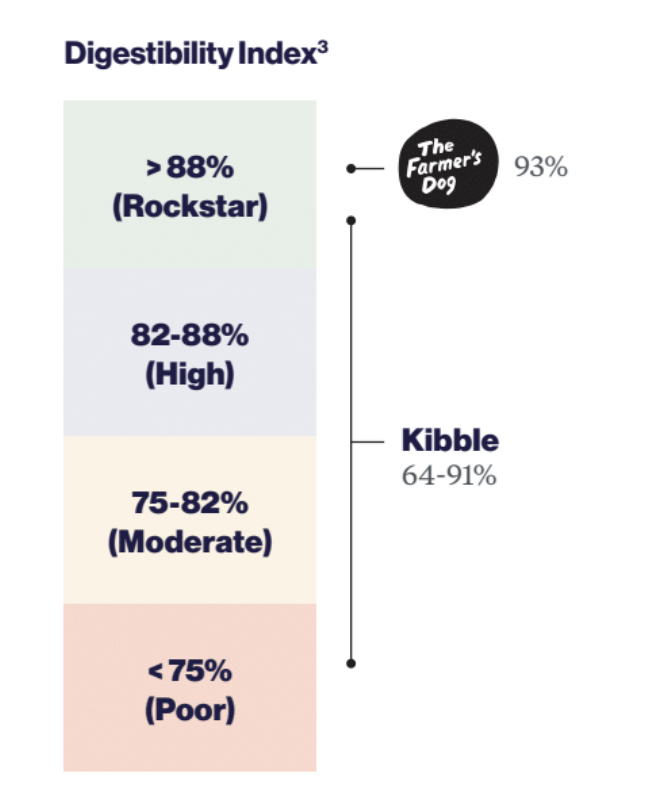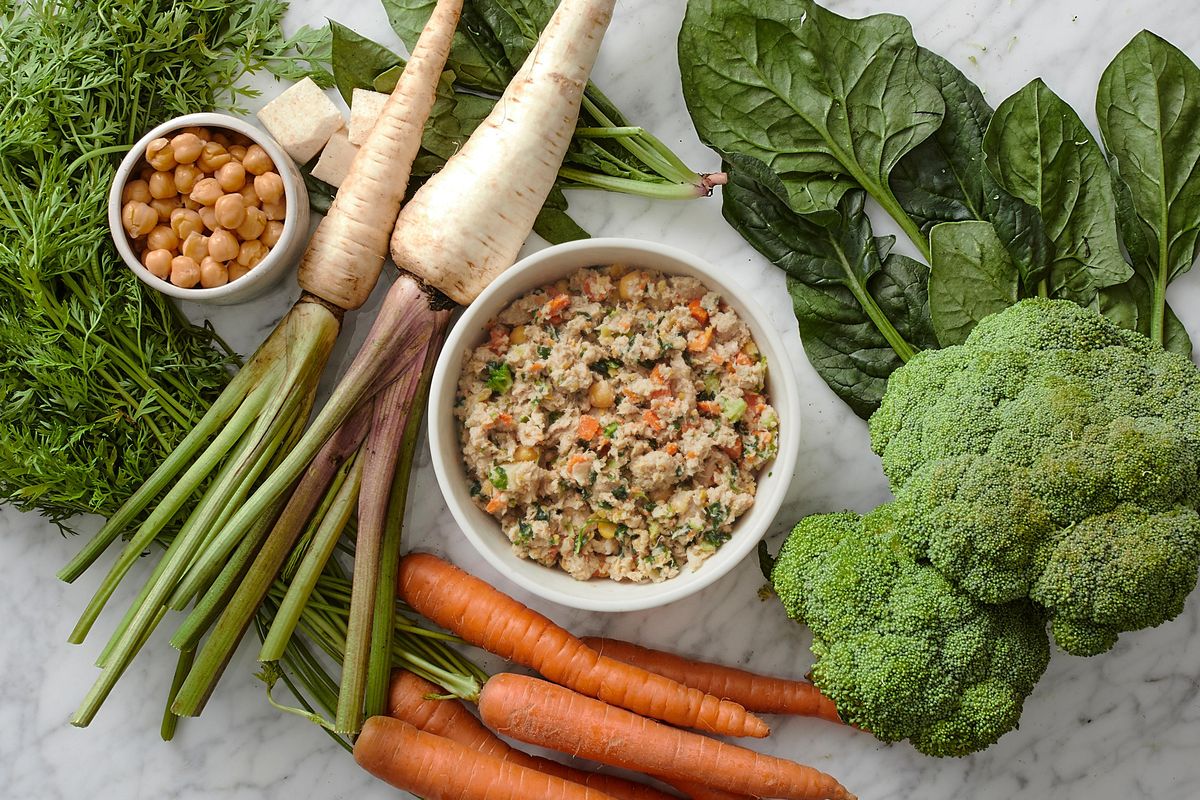When you’re evaluating the quality of a pet food, and how well it’ll fuel your dog’s body and health, you’re most likely to turn to the ingredient list, the guaranteed analysis (the chart showing percentages of protein, fat, fiber, and moisture), and to the “complete and balanced” stamp on the package.
All of those things are important, but they don’t tell the whole nutritional story. One vital measure of pet food quality is how digestible it is.
Digestibility is a key indicator of a food’s quality—if a food is highly digestible, it means that your dog is actually getting the nourishment the food is designed (or advertised) to provide. That seems like a basic test for a daily diet to pass, but many commercial, dry diets promising “premium” ingredients and “meat as the first ingredient” are actually poorly digestible.
Here’s what to know about this key metric, what constitutes good vs poor digestibility, and why fresh, lightly cooked food is more digestible than most heavily processed dry food.
What is digestibility?
Digestibility is, simply, how much of a food’s nutritional value can be absorbed into the bloodstream. You may have also seen the term “bioavailable,” a closely related term which means the proportion of a nutrient that enters the bloodstream and can be used by the body’s tissues.
How is digestibility measured?
When it comes to digestibility, the proof is in the poop! Digestibility is typically measured through feeding tests—after a transition period, dogs are fed a set amount of a specific diet and their fecal matter is collected and analyzed. The digestibility percentage (or coefficient) is determined by measuring the total daily amount of food consumed minus the amount that’s in the poop. This results in a total tract digestibility percentage (the values can also be broken down into protein, fat, and energy, or caloric, digestibility).
So, digestibility directly affects how much stool is produced each day— but it also affects a dog’s long-term well-being.
What is good vs poor pet-food digestibility?
So how digestible are some of the most common pet foods? And how does digestibility vary by food type?
A good guideline is as follows:
Less than 75% is poorly digestible/poor quality, 75 to 82% is moderately digestible/moderate quality, over 82% is highly digestible/high-quality and above 88% is exceptionally digestible/exceptional quality (see below).
Depending on the ingredients used and extrusion process, kibble protein digestibility can range from 64 to 91%.
The Farmer’s Dog food and digestibility
The Farmer’s Dog has conducted successful feeding trials to prove digestibility and macronutrient bioavailability. We make this information available to prospective and current customers because we know digestibility is a real dietary difference-maker. It’s not enough for a dog to consume sufficient nutrients; those nutrients have to be absorbed by the body in a usable form instead of just passing through. The science reinforces that our recipes are providing complete and balanced nutrition in a form that is genuinely fueling dogs’ long-term health.
Digestibility: Why pet food ingredients and processing matter
The true quality of a pet food can be difficult to determine just from looking at the ingredients and other words and pictures on the label. Complete and balanced foods with similar ingredients and guaranteed analyses can vary significantly in digestibility.
Ingredient quality and processing can make a big difference.
Highly processed, dry food is typically made of parts of animals left over from the process of making human food. This can include hide, hair, bones, digestive systems, udders, beaks, and the like. These things sound gross, but getting past the “ick factor,” they are also less desirable as dog food ingredients—they don’t provide as much nutritional value to your dog as real muscle and organ meats. The core protein in a given kibble recipe might consist of powdered “meals” instead of whole meat, and the food may have a large proportion of corn and other starchy fillers, which similarly don’t provide the highest-quality protein and nutrients.
But even if kibble was made of better ingredients, the process typically used to make the dried balls robs the food of nutritional value.
To make dry kibble, the ingredients go through multiple rounds of high-heat processing including a process called extrusion. When the kibble “dough” goes through this process, a chemical transformation called the Maillard reaction occurs, which makes the amino acids in the food less bioavailable. The result is also reduced digestibility, as the GI tract doesn’t absorb the proteins—they end up in the colon (where they may also change the bacterial flora), and, ultimately, as poop.
Studies have proven that the process used to make commercial pet food reduces the food’s bioavailability. As one study concluded, the undesirable effects of extrusion include reduction of protein quality, decrease in palatability and loss of heat-sensitive vitamins.
In contrast, multiple studies (including our own) have found that fresh, lightly cooked food has superior digestibility and bioavailability. The Farmer’s Dog makes its recipes with human-grade meat and produce, balanced with vitamins and minerals. All of our ingredients, and our kitchens where the food is cooked and handled, meet USDA standards. Our cooking process also makes some nutrients, like beta-carotene more bioavailable than in raw foods. The result is that your dog is actually getting the powerful nutrients from the food.
One hallmark of a highly digestible diet is what we call “high-quality poop.” A digestible diet will affect the quality and quantity of your dog’s poop—it’ll be less voluminous, and less stinky than their poop on a kibble diet.
Poop aside, feeding fresh, digestible food can be a significant factor in your dog’s long-term health and wellness.
There’s a big difference between a food that has sufficient nutrient value to keep a pet alive, and a food that is contributing to the health, vitality, and longevity of a dog. There’s more evidence every day that processed food is linked to an array of health problems including obesity, high blood pressure, kidney disease and cancer, and that fresh food has real health benefits.
Digestibility is just one part of a healthy diet, but we think it’s a crucial part, and an important factor in choosing your pet food.
The post All About Pet-Food Digestibility appeared first on The Farmer's Dog.


Comments
Post a Comment